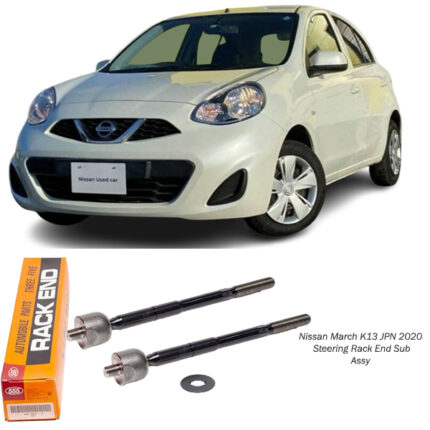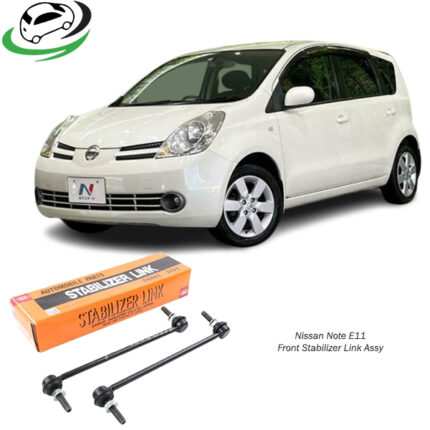Get Nissan Note E11 Front Stabilizer Link Assy SLN270 in Kenya
The Front Stabilizer Link Assembly, also known as a sway bar link or anti-roll bar link, is an integral part of a vehicle’s suspension system that enhances stability, control, and ride comfort. It connects the stabilizer (or sway) bar to the suspension struts or control arms, helping manage the vehicle’s weight distribution and reducing body roll when the car navigates corners. Let’s break down the design, function, benefits, common wear symptoms, and best practices for maintenance of the front stabilizer link assembly.
1. Understanding the Front Stabilizer Link Assembly
The front stabilizer link assembly is located in the front suspension system, between the sway bar and the suspension arms or struts. This linkage structure ensures that when the vehicle turns, the stabilizer bar is able to control the movement, preventing one side of the car from dipping lower than the other and thus minimizing body roll. In simpler terms, the stabilizer link assembly stabilizes the car during turns by connecting both sides of the suspension and ensuring balanced movement across the wheels.
There are different types of stabilizer link assemblies, but they generally include the following components:
- Link Rod: A sturdy, typically metal rod that connects the sway bar to the suspension arm or strut.
- Ball Joints or Bushings: Either ball joints or bushings, often made of rubber or urethane, are at each end of the link rod, allowing for smooth articulation and flexibility as the vehicle’s suspension moves up and down.
- Bolts and Fasteners: These secure the link to the sway bar and suspension arm. High-strength bolts are used to keep the assembly stable during operation.
2. Functions of the Front Stabilizer Link Assembly
The primary role of the front stabilizer link assembly is to reduce body roll and improve stability during cornering. The specific functions include:
- Minimizing Body Roll: When a vehicle turns, centrifugal force pulls it outward, causing the body to lean or roll in the opposite direction. The stabilizer link connects the sway bar to the suspension, reducing this body roll and helping the wheels maintain better contact with the road.
- Enhancing Vehicle Stability: By reducing body roll, the stabilizer link assembly keeps the car more level, which enhances overall stability, especially during sharp turns or emergency maneuvers.
- Improving Handling and Control: With the sway bar properly attached, the stabilizer link ensures that the weight is evenly distributed across both wheels on the axle, which improves handling, traction, and control, particularly on curves and bumpy roads.
- Reducing Suspension Wear: Since it helps distribute force evenly across the suspension components, the stabilizer link assembly reduces excess stress on individual suspension parts, potentially extending their lifespan.
3. Benefits of a High-Quality Front Stabilizer Link Assembly
Investing in a high-quality stabilizer link assembly offers several advantages, including:
- Improved Cornering Performance: A well-functioning stabilizer link assembly keeps the car level and enhances stability in turns, providing a more responsive and enjoyable driving experience.
- Enhanced Safety: Reduced body roll and improved handling mean that the driver has better control over the vehicle in various driving conditions, reducing the risk of accidents.
- Extended Tire and Suspension Life: By evenly distributing weight and load, the stabilizer link assembly helps prevent premature tire wear and reduces strain on other suspension components, saving on maintenance costs over time.
- Noise Reduction: A properly working stabilizer link assembly eliminates rattling or clunking noises caused by looseness or wear, resulting in a quieter ride.
4. Symptoms of a Failing Front Stabilizer Link Assembly
Over time, the front stabilizer link assembly can wear out or become damaged, especially in vehicles driven frequently on rough or uneven roads. Common signs of a failing stabilizer link include:
- Clunking or Rattling Sounds: One of the most common indicators of a worn stabilizer link is a clunking or rattling noise coming from the suspension area. This noise is often heard when going over bumps or during turns and is caused by looseness in the connection between the stabilizer link and sway bar.
- Increased Body Roll: If the stabilizer link assembly is failing, the vehicle may feel less stable during turns, with an increased body roll sensation. This is a sign that the sway bar is not effectively controlling the movement between the wheels.
- Poor Handling and Response: A loose or damaged stabilizer link can impact the handling of the vehicle, making it feel less responsive, especially during high-speed turns or on rough roads.
- Visible Wear or Damage: Visual inspection may reveal wear on the bushings, corrosion on the metal parts, or looseness in the link assembly. If the bushings are cracked, or the bolts show signs of rust, the stabilizer link assembly may need replacement.
5. Causes of Stabilizer Link Assembly Wear
Several factors can cause the stabilizer link assembly to wear out over time:
- Rough Road Conditions: Frequent exposure to potholes, bumps, and uneven road surfaces increases the wear on stabilizer link assemblies.
- Heavy Loads: Driving with heavy loads or regularly towing can put additional strain on the suspension system, including the stabilizer link.
- Corrosion: Water, road salt, and debris can cause rust and corrosion on the metal parts of the stabilizer link, weakening its structural integrity.
- Age and Mileage: Like all mechanical parts, the stabilizer link assembly has a limited lifespan and will wear out after a certain period or mileage. Most stabilizer links can last anywhere from 50,000 to 100,000 miles, depending on driving conditions.
6. Maintenance and Replacement of the Front Stabilizer Link Assembly
While stabilizer link assemblies are durable, they are not immune to wear. Proper maintenance and timely replacement can help maximize their performance and longevity.
- Regular Inspections: Conduct regular inspections of the stabilizer link assembly, particularly if you hear noises or experience unusual handling. Look for cracks in the bushings, signs of rust, or looseness in the assembly.
- Lubrication: Some stabilizer links come with grease fittings that require periodic lubrication. Regularly greasing these fittings can reduce friction and extend the life of the link assembly.
- Driving Caution on Rough Roads: Avoid rough terrain and drive cautiously over bumps and potholes to minimize wear on the stabilizer link assembly.
Replacement Process
When the front stabilizer link assembly is worn out, replacing it is relatively straightforward but requires specific tools and attention to detail:
- Raise the Vehicle: Use a jack to lift the vehicle and secure it on jack stands to access the suspension area.
- Remove the Old Link: Use a wrench to remove the bolts connecting the stabilizer link to the sway bar and suspension arm. In cases of corrosion, penetrating oil may be needed to loosen the bolts.
- Install the New Link: Insert the new stabilizer link, ensuring it aligns with the sway bar and suspension mounting points. Tighten the bolts to the manufacturer’s torque specifications to prevent over-tightening, which could cause premature wear.
- Test Drive: Once installed, test the vehicle to ensure the new stabilizer link assembly is functioning correctly and the suspension is stable.
Replacing stabilizer links in pairs is often recommended, as this ensures balanced handling on both sides of the vehicle.
7. When to Replace the Front Stabilizer Link Assembly
While stabilizer links are typically durable, replacement is necessary when signs of wear are present. Replacement intervals may vary depending on driving conditions and maintenance practices, but signs such as noise, poor handling, and visible wear indicate that the stabilizer link assembly should be replaced. Regular inspections during routine maintenance can also help catch potential issues early.
8. Advantages of Quality Stabilizer Links and Advanced Technology
Today, high-quality stabilizer link assemblies may include advanced materials and technologies for enhanced durability and performance. These upgrades include:
- Polyurethane Bushings: Many aftermarket stabilizer links use polyurethane instead of rubber, providing better durability, less flex, and improved handling characteristics.
- High-Strength Alloys: Modern stabilizer links often use alloys that are both lightweight and resistant to corrosion, prolonging the lifespan of the link.
- Enhanced Seals: Some stabilizer links come with improved sealing technology to protect the ball joints or bushings from contaminants, reducing maintenance needs and wear.
9. Conclusion
The front stabilizer link assembly is essential for a vehicle’s stability, handling, and safety. It connects the sway bar to the suspension, managing body roll and distributing weight effectively. By enhancing control, reducing body roll, and ensuring even distribution of forces, the stabilizer link plays a key role in providing a smooth, comfortable, and safe driving experience. Regular inspections, prompt replacement of worn links, and cautious driving on rough terrain can help extend the life of this component and improve the vehicle’s overall performance.
Follow us on Facebook for more parts.




